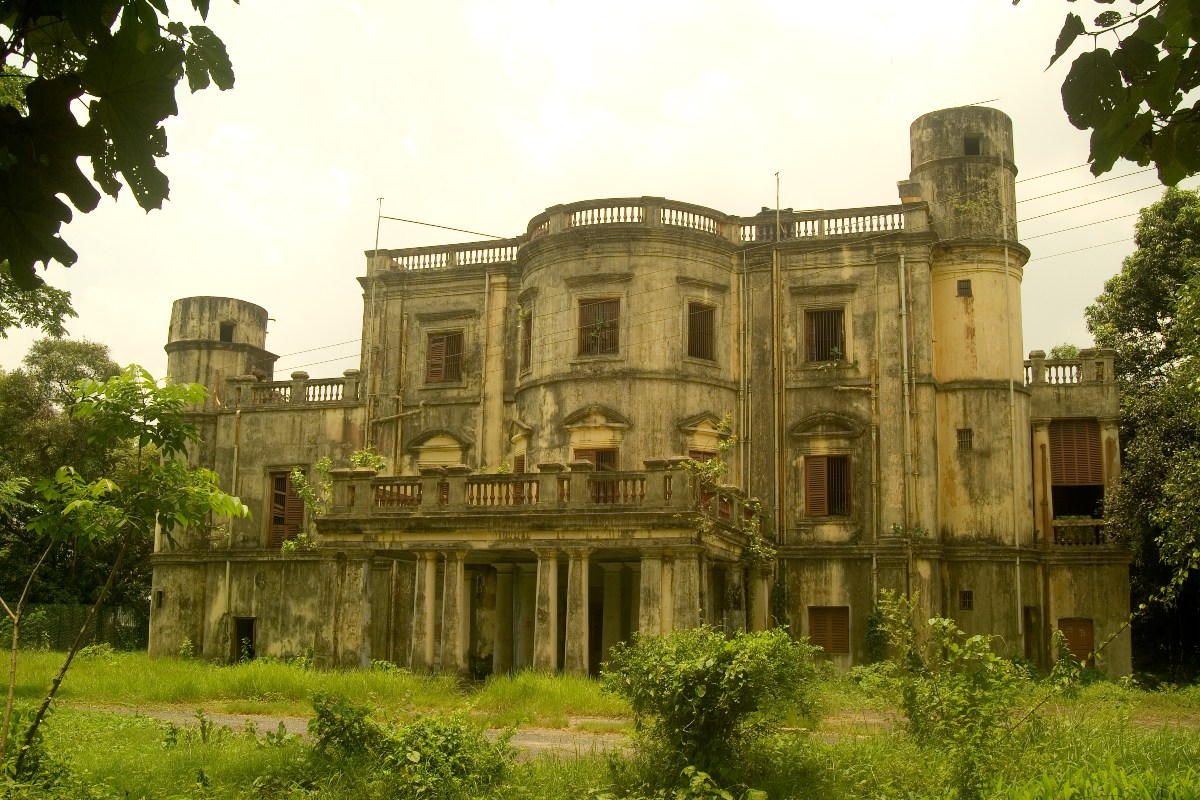
AJC Bose Indian Botanical Garden
A botanic garden can be called as an open museum of living collection of myriad of plants, where trees, shrubs, herbs, climbers, lianas etc. are scientifically arranged, properly labelled based on an internationally accepted classification, and more closely allied groups/plants are specially grown together for better understanding of species. In the Botanic Garden, trees are confined to a special section called Arboretum; gymnosperms including pine trees are arranged in Pinetum; Screwpines i.e. Pandanus are grown in Pandanetum; Orchids are assembled in Orchidarium; Bamboos are nurtured in Bambusetum and Palms are conserved in Palmetum.
According to Almond (1993), the Botanic Garden is an ever changing museum of living plants. Chakravarthy and Mukhopadhyay (1990) described Botanic Garden as a living repository or refugia of plants arranged and maintained on some scientific basis and where the collections are usually labelled or marked for identification. Heywood (1983), of the view that the Botanic Gardens and arboretum are at best represent the last resort for the preservation and maintenance of rare and endangered species.
A person who visits any botanic garden with a true spirit of getting acquainted with plants will definitely get a fair idea of the wonderful world of plants. Botanic garden also acts as an open natural laboratory by providing ample opportunities to Botanists, Horticulturists, Plant Breeders, Geneticists, Evolutionary Biologists, Palynologists, Conservationists, Environmental Scientists and other researchers alike to perform their study on multiple aspects of plant biology.
At the present scenario, the Botanic Gardens act as a best platform to address following things.
· Botanic gardens are ideal places to teach people about the richness of the plant kingdom and the impact of climate change on the richness of species.
· It envisages the intricate relationships that plants have developed from time to time with their environment.
· To let people know that how human beings dependent on plants for daily needs -economically, culturally and aesthetically.
· To make people aware of the major threats to plants and the consequences of plant extinction and to evolve possible solution thereof.
· To teach people that how we can act to prevent the destruction of natural wealth and ecosystem.
Important roles of Botanic Gardens are:
· Traditionally, comparative study of living and preserved herbarium (dried flattened specimens mounted on a cardboard or thick paper with proper label and identity) specimens is being made through botanic gardens for clear understanding of specific species.
· To introduce, grow and multiply important economic plants from around the globe and to carry out acclimatization study in different trial plots so as to release for cultivation in newer areas.
· To act as a living data base of plants and a repository of native and exotic species.
· To introduce and conserve Endemic, Endangered & Threatened (EET) species and to carry out research on the biology and propagation of said species for reintroducing in the wild as well as for effective conservation of germplasm.
· To develop improved varieties of economically important plants of the region for commercial exploitation by conducting various horticultural researches such as hybridization, selection, cross pollination, trial etc.
At present there are about 2000 gardens and arboreta around the world in the last 30 years botanic gardens have seen as a revival as scientific institutions due to the emergence of conservation movement.
Acharya Jagadish Chandra Bose Indian Botanic Garden, Howrah.
Indian Botanic Garden (IBG), Howrah formerly known as ‘Company Bagan’, the Royal Botanic Garden (RBG), Kolkata, at present AJC Bose Indian Botanic Garden (AJCBIBG), Howrah, is one of the best landscaped gardens in the world. The original history of IBG is almost similar to the Kew Garden in England which is situated on the bank of the river Thames, a few miles away from London. The Kew garden is about 50 years younger to IBG, Howrah which owes its interests in the Botany of Royalty but the latter has been established with economic and scientific aims. The Kew garden started initially with a meager area of 15 acres of land in 1841 and during the course of time it grew further under the hands of a well-known botanist Sir William Hooker, the first director of Royal Botanic Garden, Kew and now it possesses 288 acres. The Royal Botanic Garden, Kolkata, on the contrary, situated on the bank of river Hooghly a few kilometres away from Kolkata, initiated in a vast area of more than 300 acres of land and it was regarded as the largest and one of the oldest botanic gardens in the world till the middle of 19th century and now occupies an area of 273 acres.
At present, the garden having an area of 273 acres and being a living repository of 1377 plant species and tallying to a number of 14122 plants including trees, shrubs & climbers, possesses 25 divisions and 24 interconnected lakes, and the lakes are connected to the Ganges through sluices for the regular inlet and outlet of water. The garden is a unique place of learning & rich array of curiosity and occupies matchless attractions like the ‘Great Banyan Tree’, a living wonder in the plant kingdom; the Large Palm House containing rich collection of palms including Lodoicea maldivica (the double coconut palm); Branching palm (Hyphane thebaica) introduced from Egypt; The century Palm (Corypha macropoda) ; The Giant Water Lily (Victoria amazonica) brought from Amazon river; The queen of flowering trees (Amherstia nobilis) a native of Burma; The mountain rose or Venezuelan rose (Brownea sp.); The Baobab tree or Kalpavriksh (Adansonia digitata) native of Africa; The Rosogolla tree (Chrysohyllum cainito); The Cannon ball tree ( Couroupita guianensis); The African Sausage tree ( Kigelia pinnata) and the mad tree (Pterigota alata var.irregularis) etc., are the few to mention.
It was only due to the immense wish and untiring effort of a keen horticulturist Col. Robert Kyd, the then superintendent of the Hon’ble East India Company’s dockyard and secretary to the military board at Fort William of the Bengal infantry, a decision for setting up a botanic garden in Kolkata was evolved. During this time Bengal was reeling through the aftermath of ‘Great Bengal Famine’ and subsequent failure of crops. East India Company was in search of adequate and effective measures to wade off the re-occurrence of famine. Col. Kyd in his historical letter on first January 1786 suggested to Sir. John Macpherson, then the officiating governor General of India, concerning the merit of establishing a Botanic Garden which further reads as “If properly supported it cannot fail of success in bringing from other countries such
fruits and esculent vegetables as the soil and climate of Bengal is adapted to produce ………..nor can it fail of drawing from the jungles and deserts hitherto unexplored articles of Commerce, and promoting the cultivation of articles useful to the manufacturers of Great Britain and consequently important to the investment of India” and he continues “ I doubt not, under your Lordship’s influence and direction, we shall in a few years be enabled not only to afford all the articles now required from India, China and Arabia but to effect plantations of them to the aggrandizement of the power and commerce of Great Britain and to increase of the wealth and happiness of the nations subjected to your Lordship Government”. Without much delay permission for setting up a Botanic Garden in Kolkata was given to Kyd’s proposal with the approval of Court of Directors in England, the present site of the garden then measuring about 310 acres below Kyds private garden in Shalimar was acquired.
Col. Kyd being the first honorary superintendent of the garden was instrumental in introducing many exotic plants. He continued as superintendent till his death in 1793. A monument was erected to his memory in 1795 on the site selected by him (it is located almost at the centre of the Garden). It is a remarkable marble pedestal carrying a beautiful marble urn designed by Banks, the sculptor, bearing a carved inscription “Robert Kyd, Mil.Trib.Horti.Fundatori, posuit. A.K.MD. CCXCV.”
Dr.William Roxburgh, the Companies Botanist in Madras, was appointed as the first official Superintendent in 1793. Roxburgh was the first to draw up a catalogue of 3,500 plants then growing in the Garden. Later it was published as “Hortus Bengalensis” in two volumes by Rev.Dr. William Carey in 1814. Roxburgh’s monumental work on Indian Plants rightly earned him the title of “Father of Indian Botany”. The famous scientific society under the title of “United Brotherhood” was established by this time by John Gerald Koenig, a student of Linnaeus who was the guiding spirit of proper botanical studies in India. William Roxburgh died at Edinburgh in 1815. A monument, erected in 1882 on the northern side of the Great Banyan Tree perpetuates his memory. Afterwards, various luminaries like H.T. Colebrook, Sir Buchanan Hamilton, James Hare and Thomas Casey held the charges of the Garden from 1813 to 1816.
In 1817, Nathaniel Wallich, an efficient and energetic botanist, was appointed as the Superintendent of the Garden. He was the long serving superintendent in the history of Indian Botanic Garden and held office until 1846. During this time the eastern side of the garden measuring 40 acres, including the teak plantation, was given to the Lord Bishop of Kolkata (Dr. Middleton) as the site for a Christian college known as the Bishop’s College. This college grew further and at present attained the status of a well known institute i.e. Indian Institute of Engineering Science and Technology (IIEST), Shibpur. In 1836 about 2 acres of land were allotted to the Agricultural and Horticultural Society of India which was founded by Rev.Dr.William Carey its first president. It expanded further to about 25 acres and carried out operation with the help of Garden officers until 1872. In 1872 the Society’s garden was transferred to its present site in Alipur near the Viceroys House (Belvedere). Dr.Wallich died in 1854; his immense contribution to Botanical science always memorable and especially his very rich collection of plant specimens and the famous irreplaceable catalogue known as ‘ Wallich’s Catalogue' kept at Central National Herbarium, Kolkata. His friends and admirers erected a monument in his memory near the present Pinetum No.I (opposite to Bambusetum). After Wallich, many important persons such as Dr. Hugh Falconer, Dr. G. McClelland, Dr. Thomas Thomson, Dr. Thomas Anderson, Mr. C.B. Clarke etc., held office.
In 1864 occurred the great cyclone of Kolkata; accompanied by a storm wave from the river Hooghly resulted the greater part of the Garden inundated under water, in some places water level raised nearly 8 feet, and carried two ships into the Garden with great violence. One half of the total number of trees including innumerable shrubs was prostrated. The surviving numbers were much devastated, and scarcely a vestige of leaf, flower or fruit remained. Three years later a less severe but still a very destructive cyclone occurred in which over 750 of the surviving trees were blown down. Thomas Anderson strived hard throughout his remaining period to remove the wreckage and to give effect to the systematic planting of the garden before his departure in 1868.
Dr. George King who took charge as superintendent in 1871 becomes the re-maker of the garden (The present landscape of the garden was made by him). He took the charge when the garden was in most unpromising state. The devastating cyclones occurred subsequently left garden’s most of the area under the heavy growth of coarse grass and partial swamp. Most of the roads were narrow often subjected to flooding and unfitted for carriage traffic; and the lakes were represented by unpleasant channels and tanks.
Dr. King’s strong determination and deep commitment turned the garden into the present form. The whole extend of the grounds has been raised in level, necessary soil have been cut out in the form of large sheets which turned into artificial lakes. These lakes were connected one another through underground pipes and a steam pump has been fitted by which water can be sucked from the Ganges and water in the whole system can be kept at a high level. Numerous wide roads and foot paths have been made for the easy movement of carriages and people. The old style of conservatories (Bamboo and mat erections) has been replaced by large, attractive and efficient structures of iron on which a thin thatch of grass is spread for growing tropical plants. The valuable herbarium collections has been suitably housed in a handsome building designed by the then Govt. Architect. Mr. E.J. Martin. New propagation houses, tool, and potting sheds have been erected, and fine dwelling houses have been built for the members of the establishment. A boundary wall and canal have been built partly around the Garden. The collection of plants has been increased considerably, both indigenous and exotic. Communication to the Garden by road and steamer also improved. For acquiring such great achievement Dr. King has been knighted as ‘SIR’ by the queen and later he was known as Sir. Dr. George King. He is also the founder director of Botanical Survey of India in 1890.
Lt. Col. David Prain succeeded Sir. George King, who, after 26 years of meritorious service, retired in 1897. Before Sir David left India in 1904, he sketched out a geographical plan of garden divisions in accordance with which future plantings were to be regulated. Sir David Prains plan with slight modifications, continued to be carried on by his successors.
Lt. Col. A.T.Gage succeeded Sir David as superintendent of the Garden in 1906. A catalogue of non-herbaceous phanerogams cultivated in the Royal Botanic Garden, Calcutta, prepared during Lieutenant- Colonel A.T. Gage’s time was published with the object of facilitating the exchange of plant materials with other institutions. Mr. Calder succeeded Col. A.T.Gage in 1923. During Mr. Calder’s absence on leave from India Dr.J.M.Cowan acted as superintendant from 12th July 1926 to 20th November, 1927.
In 1937, K.P.Biswas, the first Indian, joined as Superintendent of the Garden and remained until 1955.
The present name of ‘AJC Bose Indian Botanic Garden’ came into existence from 24th June, 2009.
Introduction of milestone species in the Garden:
Indian Botanic Garden in Howrah undoubtedly played a significant role in introducing, multiplying and distributing many commercially important plants from various parts of the world. Introduction of some of the notable species directly influenced the welfare of people and economic development of the country.
Tea:
It is very difficult for us to imagine a single day to pass without having a cup of tea. The cultivation and brewing of tea in India has a long history of applications in traditional system of medicine and for consumption. The exact date of introduction of tea in India from China is not clearly known. It is known that the tea was first introduced in India in Indian Botanic Garden, Howrah from Guangzhou (Canton) during Roxburgh’s period. East India Company constituted a tea committee consisting of Dr. N. Wallich, G. J. Gordon, and W. Grant to promote tea cultivation in India. However, Chinese tea could not develop much interest on people.
It was in 1823 when Robert Bruce (An army officer) while travelling in Assam over the Brahmaputra encountered a few tribes known as ‘Singpho’ and ‘Khamti’, near river Dihang, saw they prepare and consume tea from local tea bushes. His younger brother Alexander followed up his brothers findings brought some seedlings of this plant from the locality at later stages and introduced in Indian Botanic Garden, Howrah. Afterwards, in 1834 Francis Jenkins made large scale trial of tea cultivation in Indian Botanic Garden, Howrah and forwarded some specimen to Dr. Wallich who identified it as Camellia theifera, the source of tea. Thus, the Garden laid the foundation of tea cultivation in India.
Today, India is one of the largest tea producers in the world, though over 70% of the tea is consumed within India itself. A number of renowned teas, such as Assam and Darjeeling also grow exclusively in India. The Indian tea industry has grown to own many global tea brands, and has evolved to one of the most technologically equipped tea industries in the world. Tea production, certification, exportation, and all other facets of the tea trade in India are controlled by the Tea Board of India.
Cinchona:
The medicinal properties of the cinchona tree were originally discovered by the ‘Quechua’ peoples of Peru and Bolivia, and long cultivated by them as a muscle relaxant to halt shivering due to low temperatures. The Jesuit Brother Agostino Salumbrino (1561–1642), an apothecary by training and who lived in Lima, observed the Quechua using the quinine-containing bark of the cinchona tree for that purpose. While its effect in treating malaria (and hence malaria-induced shivering) was entirely unrelated to its effect in controlling shivering from cold, it was nevertheless the correct medicine for malaria.
It was the horrific scene of epidemic Malaria prevailing in Indian sub-continent at the time of Thomas Anderson when he became the superintendent of India Botanic Garden, Howrah in 1861, and then thousands of people die annually due this disease. Anderson played a key role in the introduction of Cinchona plants in India. He brought several species of Cinchona from Kew (the plant is originally from South America) in 1861 raised its seedling in Indian Botanic Garden, Howrah for field trial. Later Anderson introduced Cinchona Cultivation in Mungpu and Darjeeling Hills. Due to his ailing health Anderson could not complete the job, and the task was subsequently taken over by other superintendents like C.B.Clarke and George King. They also acted as superintendents of Cinchona plantation at Mungpo. During the time of Dr. George King, a cheap malarial drug ‘Quinine’ obtained from the alkaloids of Cinchona succirubra grown at Mungpo was tested effectively and approved by Physicians and was released in the market for effective malarial cure. In such a way, Indian Botanic Garden saved lives of millions of people by giving effective cure for malaria.
Rubber:
Hevea brasiliensis, the para rubber tree initially grew only in the Amazon rainforest. The name of the tree derives from Para, the second largest Brazilian state, the capital of which is Belem .These trees were used to obtain rubber by the natives that inhabited within its geographical distribution. Increasing demand and the discovery of the vulcanization procedure in 1839 led to the rubber boom that region, enriching the cities of Belem and Manaus.
Sir. George King in 1873 brought a few seedlings of Hevea brasiliensis ( para rubber) given by Sir. J.D.Hooker, the then Director of Royal Botanic Garden, Kew for cultivation in Indian Botanic Garden, Kolkata. He tried a lot to establish those plants in Kolkata. However, he often encountered setback as because the climate of Kolkata is unsuitable for rubber cultivation. Later he sent those plants to other climatically suitable areas of British Empire such as Burma, Malaya, South India and Ceylon. Now we can see that the rubber is the chief economic crop in these areas.
Mahogany:
The famous Mahogany Avenue of Indian Botanic Garden is familiar to visitors. It is the testimony for the successful introduction of high quality timber yielding mahogany from West Indies in Indian Botanic Garden, Howrah in 1795, just after a few years of inception of Garden. Sir. J. D. Hooker, then the Director of Kew Botanic Garden in England, supplied several species of mahogany to establish in Indian Botanic Garden, Howrah. Large scale multiplication of mahogany carried out here and distributed to different parts of India. Today it is one of the unparallel timbers of high quality found in the forest areas of India.
Commercial introduction & Multiplication:
The garden has served as a platform for acclimatization and distribution of a number a large number of economic and spices pecies like Cardamom, Cinchona, Cinnamon, Coffee, Cotton, Indigo, Nutmeg, pepper, Clove, Sugarcane, potato, Sago, teak etc., and other species used as forage, fodder, oil, fruit, fibre, timber and ornamental plants were first introduced into this historical Garden. Multiplication of most of the introduced species carried out in the Garden itself and distributed to different parts of the country for commercial cultivation. Some of the other interesting plants were also introduced through this garden such as Amherstia nobilis (the queen of flowering trees) from Burma in 1826 by Nathaniel Wallich; Allamanda sp. in 1803 by W. Hamilton; Bougainvillea sp. in 1803 by W. Hamilton; Garden Croton in 1798 by C. Smith; Australian pine in 1798; Crescentia cujete ( Calabash tree) in 1795 by W. Hamilton; Lodoicea maldivica (the Double Coconut) in 1874 by Sir George King; Passion flower in 1797; Chinese rose in 1794 by William Roxburgh; Victoria amazonica (the Giant Water lily) in 1873 by Sir George King. The foregoing examples are only a few to mention.
A shift in paradigm:
The historic Earth Summit (United Nations Conference on Environment and Development –UNCED) held in Rio de Jeneiro in Brazil from 3rd June to 14th June 1992 and the subsequent opening of Convention on Biological Diversity(CBD) for discussion and signature of participating countries made a new start towards redefinition of measures for conserving world biodiversity.
The CBD especially emphasized the need of conserving world threatened species and the role Botanic Gardens (ex-situ conservation) can play in conserving thousands of vanishing Rare, Endangered and Threatened plant species from their natural habitats. The Convention on Biological Diversity (CBD), known informally as the Biodiversity Convention, is an international legally binding treaty. The past conservation efforts were aimed at protecting particular species and habitats, the Convention recognizes that ecosystems, species and genes must be used for the benefit of humans. However, this should be done in a way and at a rate that does not lead to the long-term decline of biological diversity.
The convention recognized for the first time in international law that the conservation of biological diversity is "a common concern of humankind" and is an integral part of the development process. The agreement covers all ecosystem species, and genetic resources. It links traditional conservation efforts to the economic goal of using biological resources sustainably. It sets principles for the fair and equitable sharing of the benefits arising from the use of genetic resources, notably those destined for commercial use. It also covers the rapidly expanding field of biotechnology through its Cartagena Protocol on Bio safety, addressing technology development and transfer, benefit-sharing and bio safety issues. Importantly, the Convention is legally binding; countries that join it ('Parties') are obliged to implement its provisions.
Government of India is being one of the parties of Convention directed National Biodiversity Strategies and Action Plans (NBSAPs), the principal instruments for implementing the Convention at the national level, to draw specific guide lines to save vanishing species of plants and animals of Indian origin from their natural habitats and to implement the same immediately.
In view of the international and national conservation scenario and urgent need of the hour, AJC Bose Indian Botanic Garden (AJCBIBG), Howrah has also made an immediate shift in strategy of Introduction of plants in the line of conservation, a major deviation from the past concept, to commensurate with the directions of Govt. of India as well as CBD.
The pattern of Change in plant Introduction.
Well before the Rio Earth Summit i.e. the way back in 1987 AJC Bose Indian Botanic Garden, Howrah has adopted and implemented a well planned decision of Introducing Rare, Endangered and Threatened (RET) indigenous plant species, in the ‘Annual Action Plans’, prior to their extinction from the wild and to multiply & conserve them so as to check the loss of species. This is evident from the introduction of plants in AJCBIBG for the past 30 years.
After the Rio Convention in 1992 the trend of introducing RET species in AJCBIBG has increased many folds and annually a large number of exclusive RET species being collected from the wild and introduced and multiplied for the purpose of effective conservation. This is has done mainly due to the loss of many key species from the wild, because of habitat loss a number of species is being pushed annually into the IUCN list of threatened plants. Nevertheless, the mission of introducing threatened species from the phytogeographically and ecologically fragile Western Ghats, Eastern Ghats, North East India and Andaman & Nicobar Islands continues to be a major target of AJCBIBG under the Annual Action Plans.













